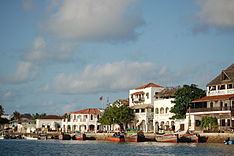Max length 10 km | Island group Lamu Archipelago | |
 | ||
Points of interest Lamu Fort, Manda Island, The Majlis, National Museums of Kenya, Lamu Museum | ||
Beauty of lamu island kenya
Lamu Island is a part of the Lamu Archipelago of Kenya. Lamu Old Town, the principal inhabited part of the island, is one of the oldest and best-preserved Swahili settlements in East Africa. Built in coral stone and mangrove timber, the town is characterized by the simplicity of structural forms enriched by such features as inner courtyards, verandas, and elaborately carved wooden doors. Lamu has hosted major Muslim religious festivals since the 19th century, and has become a significant center for the study of Islamic and Swahili cultures.
Contents
- Beauty of lamu island kenya
- Map of Lamu Kenya
- Kenya s lamu island feels the pinch of travel advisories
- Shela
- Matondoni
- Kipungani
- In popular culture
- References
Map of Lamu, Kenya
The island is linked by boat to Mokowe on the mainland and to Manda Island, where there is an airport. There are no roads on the island, just alleyways and footpaths, and therefore, there are few motorized vehicles on the island. Residents move about on foot or by boat, and donkeys are used to transport goods and materials.
A port was founded on the island of Lamu by Arab traders at least as early as the fourteenth century, when the Pwani Mosque was built. The island prospered on the slave trade. After defeating Pate Island in the nineteenth century, the island became a local power, but it declined after the British forced the closure of the slave markets in 1873. In 1890 the island became part of Zanzibar and remained obscure until Kenya was granted independence from Great Britain in 1963. Tourism developed from the 1970s, mainly around the eighteenth century Swahili architecture and traditional culture.
Kenya, South Sudan and Ethiopia have launched the controversial LAPSSET development project to build a port, oil refinery and rail network near the island of Lamu, the Lamu Port and Lamu-Southern Sudan-Ethiopia Transport Corridor.
In addition to Lamu Town, there are three villages on Lamu Island: Shela, Matondoni and Kipungani.
Kenya s lamu island feels the pinch of travel advisories
Shela
Shela is a village about 3.2 km (2.0 mi) south of Lamu (town). The origin of the village is unknown, but according to tradition, it was settled by people from nearby Manda Island. In 1813, the elite of Pate Island, allied with the Mazrui clan from Oman, attempted to subjugate Lamu in the Battle of Shela. This attempt failed totally, and the defeat of Pate at Shela signalled the rise of Lamu as the leading power in the archipelago. Shela's golden age was from 1829 to 1857, when 5 of its 6 mosques were constructed. It is especially known for the Friday mosque.
Shela is now a centre for tourism on the island, with several guest houses featured by the coast. Shela is also home to the most spectacular beaches on Lamu island, which were damaged during the tsunami caused by the 2004 Indian Ocean earthquake. The appearance of the area is much more in keeping with the imagined East African coastline, with its almost pure white sand, traditional dhows, and clean appearance. It makes a sharp contrast to Lamu town (directly opposite the airstrip on Manda) which lacks a beach and functions as a relatively busy port.
Matondoni
Known for the building and repairing of dhows, Matondoni lies at the NW coast of the island, 7.3 km (4.5 mi) west of Lamu (town). The village has a modern jetty.
Kipungani
This is a small village on the West coast of the island.
In popular culture
Michael W. Smith featured a song about visiting the island called "Lamu" on his 1986 album The Big Picture. A different version is featured on Smith's 1987 live album The Live Set.
